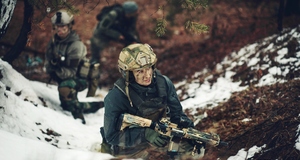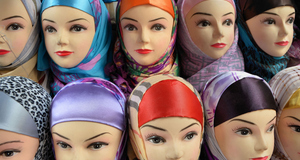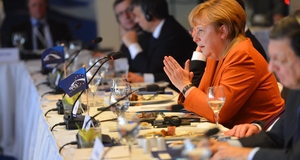|
From Interstate - Journal of International Affairs VOL. 2015/2016 NO. 1 How Important are Masculinity and Femininity in the Culture of Militaries?
By Ciaran Kovach
Interstate - Journal of International Affairs
2015, Vol. 2015/2016 No. 1 | pg. 2/2 | «
One aspect of military culture which garners a great deal of public attention and controversy, is the issue of high suicide rates amongst serving or ex- service people believed to be connected to masculine military culture. A key underlying factor in the suicides of service people is the notion of expendability within the context of a larger group. This notion is considered fundamental in the formation of social cohesive groups where individuals can resist the natural urge to not take risks with their lives. This form of emotional control creates disregard for one's life and is considered a masculine characteristic.
A major direct cause of suicides within the military, that of Post-Traumatic Stress Syndrome (PTSD), is exacerbated by the denial and stigmatisation often directed towards the issue by the US military. To be traumatised is to deny the culture of masculine emotional control.16 Joshua Goldstein explained how due to emotional suppression, many service people find themselves in a situation where they must pay the price of the warrior mentality in the forms of anxiety and PTSD, and therefore the price of failing to be properly masculine and being branded a failure and a coward.17
Ultimately, this emotional shutdown, combined with the masculine character of military society towards aggression which is sometimes internalised, leads to soldiers whose culture emphasises subordination to the group, to chastise themselves for failing the group and possibly commit suicide. Continued exclusion of servicewomen from masculine military culture reinforces the common perception that suicides rates in the military are connected to masculine military culture. While servicewomen make up 15% of the US military, 97. 5% of suicides are of servicemen. 18
A valuable perspective on the role of gender in the military can be found in the writings and commentary of feminist scholars. Feminist antimilitary analysis strongly emphasises the nature of the military as a deeply masculine organisation and argues that the role militaries play are motivated by masculine modalities of economic and political domination and sexual conquest.19 This antimilitarist feminist perspective on military culture is challenged by egalitarian militarist feminists.
These feminists choose to focus on the social dynamic of levels of citizenship, arguing that the culture of the military is not one that fundamentally oppresses women and propagates other social ills such as racism as antimilitarist feminists argue. Egalitarian militarist feminists argue that the military (namely the martial citizenship that comes with military service) constitutes a path to 'first-class citizenship' and equal rights with men.20
In examining the role of gender the military, this essay has so far largely focused on the US military, in part due to the wealth of academic material on gender issues in the US military. In order to gain a comprehensive a picture as possible however, it is necessary to contrast US gendered military culture with that of other nations. The first contrast is that between the US and Israeli military. Unlike the USA, Israel's historically precarious military situation has made the inclusion of women into the military through conscription a necessity.
It should be noted however that while the Israeli Defense Force (IDF) is willing to include greater numbers of women than other militaries, in comparison to nations such as the US, they have been more reluctant allow women to carry out 'masculine' role in the IDF. Female IDF members are limited to reserve and auxiliary roles such as drivers, instructors (a lack of respect making them less effective than men) and secretaries. Few of them receive combat training and those that do are primarily used as guards, not frontline soldiers. Female IDF soldiers are not even allowed to fly combat aircraft or be stationed on combat vessels.21
US policy towards inclusion of women also differs in regards to many of their NATO partners. Two examples provide sufficient contrasting attitudes; the Netherlands employs women on submarines (unlike the US) but excludes them from other forms of combat, and Italy, who until recently banned women from joining the military.22 In light of these comparisons, the US military remains an excellent focus for an analysis of the role of gender in military culture due to its high percentage of female military personnel and the well-known public debate about the role of women in the US military. However, comparisons with other militaries reveal that there exist differing viewpoints on if and how women are to be utilised in the military.
To conclude, the issues and case studies explored in this essay strongly suggest that gender does play a very influential role in all facets of military culture, from training to active service and beyond into lives of veterans. Military culture is firmly grounded in masculinity and issues we currently see exemplified by the treatment of female and openly gay members of the US military. This is indicative of an ongoing crisis within its culture on how to balance increasing inclusiveness demanded by modern society while maintaining the masculine practises that in many respects underpin the effectiveness of a military.
At the same time however, it must be acknowledged that militaries are not purely masculine institutions. The roles that militaries play in providing for and nurturing its personnel and their families show that militaries also have an important feminine side. As it stands, it is really quite impossible to give a definitive answer to the New York Times questions posed at the beginning of this essay, of whether the warrior is uniquely masculine in nature and whether militaries as we know them can survive 'feminization'.
Braswell, H and Harold, K. "Suicide, social integration, and masculinity in the US military." Social Science & Medicine, 24:4 (2012) pp. 530-536.
Burks, D. "Lesbian, gay, and bisexual victimization in the military: an unintended consequence of "Don't Ask, Don't Tell." The American Psychologist, 66:7 (2011) pp. 604-613.
Fallahi, C. Austad, C. Leishman, L. Gendron, Michael, G. Rebecca W. "Gender Differences in the Perception of Prisoner Abuse." Sex Roles, 2009 Feb, 60 (2009) pp. 261-268.
Feinman, I. Citizenship rites: feminist soldiers and feminist antimilitarists. (New York; London: New York University Press, 2000).
Goldstein, J. War and gender: How gender shapes the war system and vice versa. (Cambridge: Cambridge University Press, 2001).
Herbert, M. Camouflage isn't only for combat: gender, sexuality and women in the military. (New York; London: New York University Press, 2003).
Snyder, C. Citizen-soldiers and manly warriors: military service and gender in the civic republican tradition. (Lanham, Md; Oxford: Rowman & Littlefield Publishers, 1999).
Whitworth, S. Men, militarism, and UN peacekeeping: a gendered analysis. Boulder, Colo.; (London: Lynne Rienner Pub, 2004).
Whitworth, S. "Militarized Masculinities and the Politics of Peacekeeping." In Critical security studies and world politics, edited by Ken Booth. Boulder. (Colo.; London: Lynne Rienner Publishers, 2005).
Ziegler, S. Gregory G. Moving beyond G.I. Jane: women and the U.S. military. (Lanham, Maryland.; Oxford : University Press of America, 2005).
- Snyder, C. Citizen-soldiers and manly warriors: military service and gender in the civic republican tradition (Lanham, Md; Oxford: Rowman & Littlefield Publishers, 1999), p. 1.
- Whitworth, S. Men, militarism, and UN peacekeeping: a gendered analysis (Boulder, Colo.; London: Lynne Rienner Pub, 2004), p. 153.
- Herbert, M. Camouflage isn't only for combat: gender, sexuality and women in the military (New York; London: New York University Press, 2003), p. 42-43.
- Burks, D. ‘Lesbian, gay, and bisexual victimization in the military: an unintended consequence of "Don't Ask, Don't Tell,’ The American Psychologist, 66:7 (2011) p. 605.
- Burks, D. ‘Lesbian, gay, and bisexual victimization in the military: an unintended consequence of "Don't Ask, Don't Tell’, p. 606.
- Herbert, M. Camouflage isn't only for combat: gender, sexuality and women in the military, p. 43-44.
- Herbert, M. Camouflage isn't only for combat: gender, sexuality and women in the military, p. 44-45.
- Herbert, M. Camouflage isn't only for combat: gender, sexuality and women in the military, p. 45-46.
- Whitworth, S. Men, militarism, and UN peacekeeping: a gendered analysis, p. 155-156.
- Whitworth, S. Men, militarism, and UN peacekeeping: a gendered analysis, p. 157-158.
- Whitworth, S. Men, militarism, and UN peacekeeping: a gendered analysis, p. 158-159.
- Whitworth, S. "Militarized Masculinities and the Politics of Peacekeeping." In Critical security studies and world politi
- Fallahi, C et al., ‘Gender Differences in the Perception of Prisoner Abuse’, Sex Roles, 60 (2009) p. 261-265.
- Fallahi, C et al., ‘Gender Differences in the Perception of Prisoner Abuse’, p. 262.
- Fallahi, C et al., ‘Gender Differences in the Perception of Prisoner Abuse’, p. 266.
- Braswell, H and Kushner, H. ‘Suicide, social integration, and masculinity in the US military’, Social Science & Medicine, 74:4 (2012) p. 530-533.
- Goldstein, J. War and gender: How gender shapes the war system and vice versa (Cambridge: Cambridge University Press, 2001), p. 269.
- Braswell, H and Kushner, H. ‘Suicide, social integration, and masculinity in the US military’, p. 534.
- Feinman, I. Citizenship rites: feminist soldiers and feminist antimilitarists (New York ; London: New York University Press, 2000), p. 2.
- Feinman, I. Citizenship rites: feminist soldiers and feminist antimilitarists, p. 31-32.
- Zeigler, S and Gunderson, G. Moving beyond G.I. Jane: women and the U.S. military (Lanham, Md.; Oxford: University Press of America, 2005), p. 80-82.
- Zeigler, S and Gunderson, G. Moving beyond G.I. Jane: women and the U.S. military, p. 83.
Braswell, H and Harold, K. "Suicide, social integration, and masculinity in the US military." Social Science & Medicine, 24:4 (2012) pp. 530-536.
Burks, D. "Lesbian, gay, and bisexual victimization in the military: an unintended consequence of "Don't Ask, Don't Tell." The American Psychologist, 66:7 (2011) pp. 604-613.
Fallahi, C. Austad, C. Leishman, L. Gendron, Michael, G. Rebecca W. "Gender Differences in the Perception of Prisoner Abuse." Sex Roles, 2009 Feb, 60 (2009) pp. 261-268.
Feinman, I. Citizenship rites: feminist soldiers and feminist antimilitarists. (New York; London: New York University Press, 2000).
Goldstein, J. War and gender: How gender shapes the war system and vice versa. (Cambridge: Cambridge University Press, 2001).
Herbert, M. Camouflage isn't only for combat: gender, sexuality and women in the military. (New York; London: New York University Press, 2003).
Snyder, C. Citizen-soldiers and manly warriors: military service and gender in the civic republican tradition. (Lanham, Md; Oxford: Rowman & Littlefield Publishers, 1999).
Whitworth, S. Men, militarism, and UN peacekeeping: a gendered analysis. Boulder, Colo.; (London: Lynne Rienner Pub, 2004).
Whitworth, S. "Militarized Masculinities and the Politics of Peacekeeping." In Critical security studies and world politics, edited by Ken Booth. Boulder. (Colo.; London: Lynne Rienner Publishers, 2005).
Ziegler, S. Gregory G. Moving beyond G.I. Jane: women and the U.S. military. (Lanham, Maryland.; Oxford : University Press of America, 2005).
Endnotes
- Snyder, C. Citizen-soldiers and manly warriors: military service and gender in the civic republican tradition (Lanham, Md; Oxford: Rowman & Littlefield Publishers, 1999), p. 1.
- Whitworth, S. Men, militarism, and UN peacekeeping: a gendered analysis (Boulder, Colo.; London: Lynne Rienner Pub, 2004), p. 153.
- Herbert, M. Camouflage isn't only for combat: gender, sexuality and women in the military (New York; London: New York University Press, 2003), p. 42-43.
- Burks, D. ‘Lesbian, gay, and bisexual victimization in the military: an unintended consequence of "Don't Ask, Don't Tell,’ The American Psychologist, 66:7 (2011) p. 605.
- Burks, D. ‘Lesbian, gay, and bisexual victimization in the military: an unintended consequence of "Don't Ask, Don't Tell’, p. 606.
- Herbert, M. Camouflage isn't only for combat: gender, sexuality and women in the military, p. 43-44.
- Herbert, M. Camouflage isn't only for combat: gender, sexuality and women in the military, p. 44-45.
- Herbert, M. Camouflage isn't only for combat: gender, sexuality and women in the military, p. 45-46.
- Whitworth, S. Men, militarism, and UN peacekeeping: a gendered analysis, p. 155-156.
- Whitworth, S. Men, militarism, and UN peacekeeping: a gendered analysis, p. 157-158.
- Whitworth, S. Men, militarism, and UN peacekeeping: a gendered analysis, p. 158-159.
- Whitworth, S. "Militarized Masculinities and the Politics of Peacekeeping." In Critical security studies and world politi
- Fallahi, C et al., ‘Gender Differences in the Perception of Prisoner Abuse’, Sex Roles, 60 (2009) p. 261-265.
- Fallahi, C et al., ‘Gender Differences in the Perception of Prisoner Abuse’, p. 262.
- Fallahi, C et al., ‘Gender Differences in the Perception of Prisoner Abuse’, p. 266.
- Braswell, H and Kushner, H. ‘Suicide, social integration, and masculinity in the US military’, Social Science & Medicine, 74:4 (2012) p. 530-533.
- Goldstein, J. War and gender: How gender shapes the war system and vice versa (Cambridge: Cambridge University Press, 2001), p. 269.
- Braswell, H and Kushner, H. ‘Suicide, social integration, and masculinity in the US military’, p. 534.
- Feinman, I. Citizenship rites: feminist soldiers and feminist antimilitarists (New York ; London: New York University Press, 2000), p. 2.
- Feinman, I. Citizenship rites: feminist soldiers and feminist antimilitarists, p. 31-32.
- Zeigler, S and Gunderson, G. Moving beyond G.I. Jane: women and the U.S. military (Lanham, Md.; Oxford: University Press of America, 2005), p. 80-82.
- Zeigler, S and Gunderson, G. Moving beyond G.I. Jane: women and the U.S. military, p. 83.
Save Citation » (Works with EndNote, ProCite, & Reference Manager)
APA 6th
Kovach, C. (2015). "How Important are Masculinity and Femininity in the Culture of Militaries?" Interstate - Journal of International Affairs, 2015/2016(1). Retrieved from http://www.inquiriesjournal.com/a?id=1235
MLA
Kovach, Ciaran. "How Important are Masculinity and Femininity in the Culture of Militaries?" Interstate - Journal of International Affairs 2015/2016.1 (2015). <http://www.inquiriesjournal.com/a?id=1235>
Chicago 16th
Kovach, Ciaran. 2015. How Important are Masculinity and Femininity in the Culture of Militaries? Interstate - Journal of International Affairs 2015/2016 (1), http://www.inquiriesjournal.com/a?id=1235
Harvard
KOVACH, C. 2015. How Important are Masculinity and Femininity in the Culture of Militaries? Interstate - Journal of International Affairs [Online], 2015/2016. Available: http://www.inquiriesjournal.com/a?id=1235
Suggested Reading from Inquiries Journal
In her book, Maneuvers: The International Politics of Militarizing Women’s Lives (2000), Cynthia Enloe examines the role militarization plays in women’s lives. Enloe defines militarization as “a step-by-step process by which a person or a thing gradually comes to be controlled by the military or comes... MORE»
In the United Arab Emirates (UAE) and the Gulf Cooperation Council (GCC) states in general, women played an important economic role in the pre-oil era (before the 1960s) in addition to their “traditional” domestic... MORE»
Comic books, a form of American popular culture, offer a window into the past, allowing researchers to track societal changes over several decades. The purpose of this study was to determine if, how, and how much female gender roles have changed in Marvel Comics from the Silver Age (1960) to the present (2014) to help understand... MORE»
Women make up anywhere from 0% to 56% of the national legislatures around the world. Research has attributed this wide spectrum to political, socioeconomic, and cultural or ideological factors. After testing these existing... MORE»
Latest in Women's & Gender Studies
2022, Vol. 14 No. 10
The label of ‘science’ or ‘biology’ can become somewhat of a trump-card in excluding trans people from civil rights, because many scientific (and pseudo-scientific) opinions are weaponized during transgender rights debates... Read Article »
2022, Vol. 14 No. 09
Perceptions of menstruation as a taboo subject have historically characterized Western and non-Western societies alike and persist today, both perpetuating harmful cultural understandings of women’s abilities and normalizing institutional... Read Article »
2022, Vol. 14 No. 03
Using content analysis, this article focuses on the portrayal of female prisoners in the first two seasons of the Netflix show Orange is the New Black (OITNB). There are two main findings. First, the word "lesbian" frequently signals homophobia... Read Article »
2020, Vol. 12 No. 11
This paper investigates the convoluted societal processes to which the individual is exposed from an early age in order to form and acquire their sense of identity, and aims at dismantling these very processes by exhibiting their flimsy and unsubstantiated... Read Article »
2020, Vol. 12 No. 10
Centuries of subjugation under Spanish and American colonial rule have embedded an idealistic view of white beauty in the minds of Filipinos. It continues to be deeply rooted in Philippine culture due to the constant exposure of Filipina bodies... Read Article »
2020, Vol. 12 No. 10
This paper explores the woman’s body as a site of sanctity and disgust in the film Rosemary’s Baby. The character of Rosemary Woodhouse is depicted as a pure, virtuous, and feminine figure. She is positioned against other corrupted,... Read Article »
2020, Vol. 12 No. 10
Conversations about the gender expression of young children are often characterized by confusion, as parents, educators, and even child psychologists have a hard time determining where exactly children’s strong gendered beliefs and behaviors... Read Article »
|




















